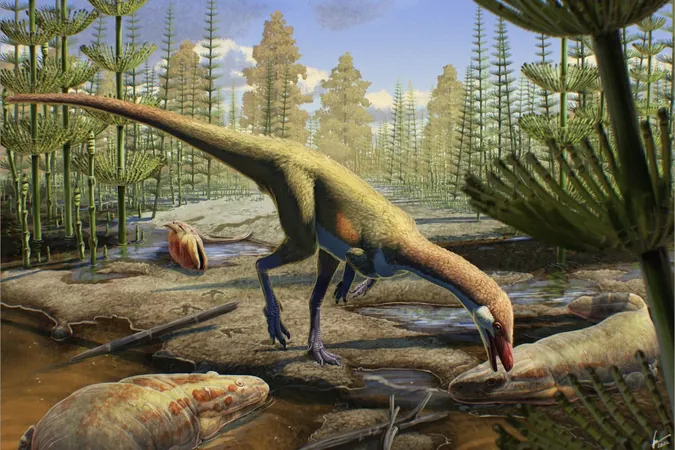
Shocking Discovery in Wyoming: 230 Million-Year-Old Fossil Upends Long-Held Dinosaur Origins Theory!
2025-01-08
Author: Ting
Groundbreaking Discovery by UW–Madison
A groundbreaking discovery by paleontologists at the University of Wisconsin–Madison (UW–Madison) is sending shockwaves through the scientific community, challenging our understanding of where and when dinosaurs originated. For decades, the conventional wisdom held that dinosaurs first appeared in the southern regions of the ancient supercontinent Pangea over 200 million years ago, later migrating northward. However, a new study published in the Zoological Journal of the Linnean Society dramatically shifts this narrative.
The Identification of *Ahvaytum bahndooiveche*
The team announced the identification of a previously unknown dinosaur species named *Ahvaytum bahndooiveche*, which reveals that these ancient reptiles inhabited the northern parts of Pangea far earlier than previous theories suggested. The fossils, unearthed in present-day Wyoming in 2013, date back around 230 million years, making them the oldest known Laurasian dinosaur. This challenges the long-accepted notion that dinosaurs developed primarily in the southern region of Pangea, known as Gondwana, before spreading northward.
Changing the Narrative
Dave Lovelace, co-leader of the study, stated, “We’re kind of filling in some of this story, showing that the ideas we’ve held for so long weren’t quite right. We now have evidence proving dinosaurs roamed the northern hemisphere much earlier than thought.” The findings indicate that these ancient creatures were not the colossal figures we typically envision; *Ahvaytum* was roughly the size of a chicken with an exceptionally long tail, measuring just over a foot tall and about three feet long.
Advanced Techniques and Historical Context
Utilizing advanced radioisotopic dating techniques, researchers confirmed the age of the fossils, revealing that *Ahvaytum* existed during the Triassic period, a vital era in the history of dinosaurs. This period marks not only the emergence of dinosaurs but also the environment that allowed them to flourish and eventually dominate land ecosystems during the Jurassic period.
Cultural Significance
Furthermore, the discovery site aligns with the ancestral lands of the Eastern Shoshone Tribe, leading to a collaborative effort involving tribal members in the research process. The name *Ahvaytum bahndooiveche* translates to "long ago dinosaur" in their language, signifying a meaningful cultural connection to the findings.
Broader Implications
In addition to the *Ahvaytum* fossils, researchers also uncovered an early dinosaur-like footprint and newly described amphibian remains, hinting that the northern parts of Laurasia may have supported varied prehistoric life even before the emergence of dinosaurs.
Conclusion: A New Era in Paleontology
The implications of this research extend far beyond just the origins of dinosaurs; they challenge existing paradigms about early Pangean ecosystems and the evolution of terrestrial life. As scientists continue to delve into the secrets of our prehistoric past, the story of *Ahvaytum* serves as a powerful reminder of how much more there is to learn about the creatures that once roamed our planet. Will this spark a complete overhaul of our understanding of dinosaur evolution? Only time will tell! Stay tuned for more astonishing revelations in paleontology!

 Brasil (PT)
Brasil (PT)
 Canada (EN)
Canada (EN)
 Chile (ES)
Chile (ES)
 Česko (CS)
Česko (CS)
 대한민국 (KO)
대한민국 (KO)
 España (ES)
España (ES)
 France (FR)
France (FR)
 Hong Kong (EN)
Hong Kong (EN)
 Italia (IT)
Italia (IT)
 日本 (JA)
日本 (JA)
 Magyarország (HU)
Magyarország (HU)
 Norge (NO)
Norge (NO)
 Polska (PL)
Polska (PL)
 Schweiz (DE)
Schweiz (DE)
 Singapore (EN)
Singapore (EN)
 Sverige (SV)
Sverige (SV)
 Suomi (FI)
Suomi (FI)
 Türkiye (TR)
Türkiye (TR)
 الإمارات العربية المتحدة (AR)
الإمارات العربية المتحدة (AR)